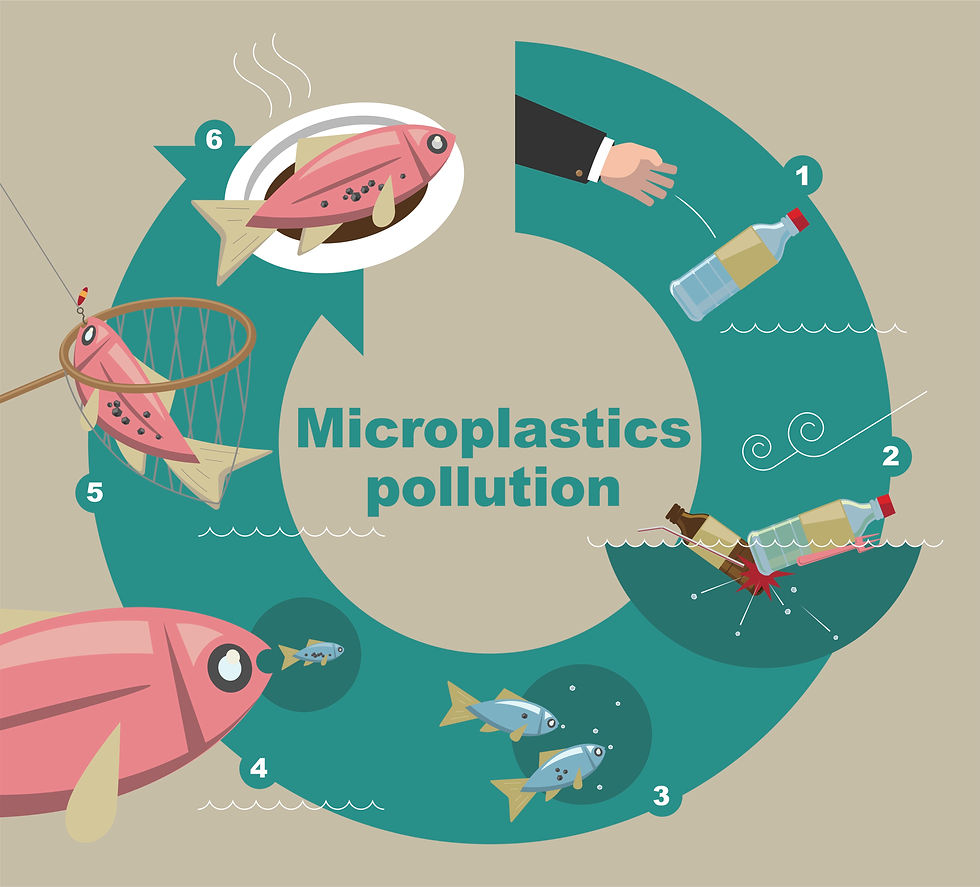The Impact of Microplastics on the Ocean and Marine Life
- Thomas

- Apr 7, 2023
- 3 min read

Microplastics and Their Effect on the Ocean
Microplastics, which are plastic particles that measure less than five millimeters in length, arise from a variety of sources like plastic bottles, bags, packaging, and fishing gear. They can be easily carried by wind and water currents and are frequently discovered in the ocean. The impact of microplastics on the marine environment is significant as it affects not only marine life but also the entire ecosystem. In this article, we will discuss the impact of microplastics on the ocean, their classification, distribution, and strategies to lessen their impact.
Classification of Microplastics
There are two classifications of microplastics, primary and secondary. Primary microplastics are manufactured as small particles for specific purposes like plastic microbeads in personal care products. Secondary microplastics, on the other hand, are produced from the breakdown of larger plastic items.
Microbeads, which are plastic particles used in personal care products like exfoliating scrubs, toothpaste, and cosmetics, are an example of primary microplastics. These particles enter waterways when washed down the drain and ultimately end up in the ocean where marine life can mistake them for food.
Another form of microplastics is plastic fibers, which originate from synthetic textiles such as clothing, fishing nets, and ropes. These fibers are discharged into the environment through laundering or from the degradation of fishing gear and other synthetic textiles.

Distribution of Microplastics in the Ocean
Microplastics are present in all parts of the ocean, from surface waters to deep-sea sediments. They tend to aggregate in areas where water converges, like in the center of ocean gyres, where they form large patches of plastic debris. They can also be found near coastlines, where they can cause significant environmental problems.
Impact of Microplastics on Marine Life
Microplastics impact marine organisms, from plankton to whales. They can consume microplastics directly or indirectly through the food chain. When ingested, microplastics can obstruct the digestive tract, causing malnutrition, internal injuries, and even death.
Marine animals can also become entangled in larger plastic items such as fishing nets and lines, resulting in physical harm or death. Additionally, microplastics can transfer toxic chemicals and pollutants to the tissues of marine animals, causing long-term health effects.
Consequences of Microplastics on the Ecosystem
Microplastics can disrupt the entire marine ecosystem. They can influence the food chain, as small organisms that consume microplastics are consumed by larger predators, including humans. In addition, microplastics can amass toxic chemicals like polychlorinated biphenyls (PCBs) and transfer them up the food chain. These chemicals can cause health problems in humans who consume seafood contaminated with microplastics.

Strategies to Lessen Microplastics in the Ocean
Removing microplastics from the ocean is a complex and challenging task. While it is possible to physically remove larger plastic items like fishing nets and debris from the surface of the ocean, removing microplastics is much more difficult as they are dispersed throughout the water column and can also be found in deep-sea sediments.
Developing new technologies to capture and remove microplastics from the ocean is a promising approach. However, these technologies are still in their early stages and require further research and development to be effective on a larger scale.
The most effective way to address the problem of microplastics is to prevent plastic waste from entering the ocean in the first place. By reducing the use of single-use plastic products, properly disposing of plastic waste, and supporting sustainable practices, we can all work together to protect the ocean and its inhabitants from the harmful effects of microplastics. Here are some methods that can aid in reducing the amount of plastic waste in the ocean:
Individual Actions
Reduce the use of single-use plastic products like straws, bags, and water bottles.
Dispose of plastic waste properly by recycling or throwing it in the trash.
Support companies that use sustainable packaging and avoid products that contain microbeads.
Participate in beach cleanups and other community efforts to remove plastic waste from the environment.
Industrial Measures
Develop and implement regulations to lessen plastic waste, such as banning single-use plastics or requiring companies to use biodegradable alternatives.
Develop new technologies to capture and remove plastic waste from the ocean.
Encourage companies to implement sustainable practices and use eco-friendly packaging.
Increase funding for research on microplastics and their effects on the environment.
Microplastics are an emerging environmental threat that poses a significant risk to the ocean and marine life. Though the problem may appear to be overwhelming, there are ways that individuals and governments can work together to reduce the amount of plastic waste that enters the ocean. By taking action, we can safeguard the ocean and guarantee its sustainability for future generations.




Comments